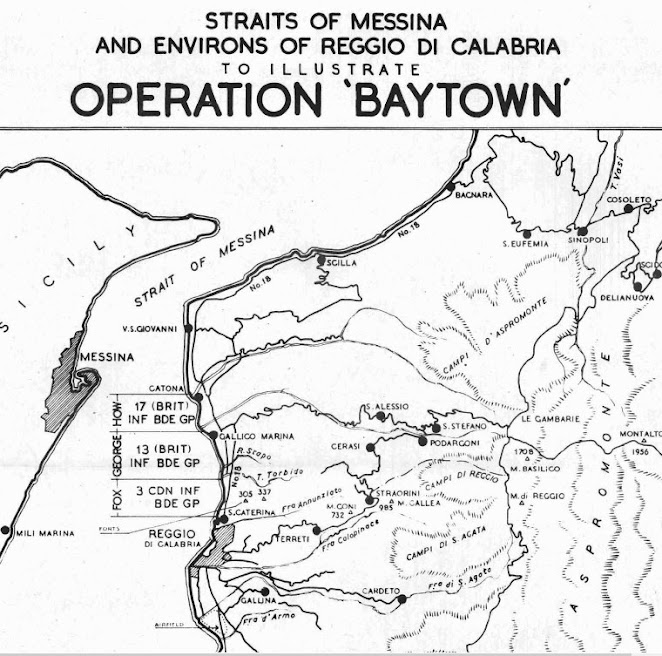"Bill" Katanna Rose Through the Ranks, from Dieppe to Italy
Key Member of the 80th Flotilla of Canadian Landing Crafts
William "Bill" N. Katanna (back left), Leading Stoker, RCNVR, Combined Ops
Editor's guess: Reggio di Calabria (toe of the boot of Italy), September, 1943
Photograph from collection of Susan Katanna (Bill's daughter)
Bill kept his LCMs in top shape for two invasions, Operations HUSKY (July) and
BAYTOWN; E.g., he transported Canadian and British troops from Messina to
Reggio di Calabria beginning September 10, 1943
10, 1943 for HUSKY, and then in Italy beginning Sept. 3 for BAYTOWN,
plying the strait from Messina to Reggio. Above 2 photos from Canadians
in the Italian Campaign, Facebook group
Introduction:
The name 'Katanna' stuck in my mind after seeing it on a rare Navy hammock along with my father's, and next in one of my father's stories about the invasion of Sicily. The hammock, displayed in the photo below, has a story attached to it, and when I was able to connect with W. N. Katanna's daughter in Manitoba (in spring 2023) I learned a bit more about the hammock's journey and a lot more about the man.
Displayed upon request at the HMCS Naden Navy Museum, Esquimalt, B.C.
Note - the hammock once belonged to W. N. Katanna; his stencilled name is
partially hidden near top of the maple leaf. Photo - collection of GH
Next is an excerpt from a chapter re the invasion of Sicily (Operation HUSKY) from my father's memoirs ("Dad, Well Done", pages 31 - 32), depicting Katanna, Harrison and Joe Watson (Simcoe, Ontario) getting rattled around inside their LCM while transporting materials of war to GEORGE Beach, now modern day Fontane Bianche:
July 10, 1943. We arrived off Sicily in the middle of the night and stopped about four miles out. Other ships and new LCIs (landing craft infantry), fairly large barges, were landing troops. Soldiers went off each side of the foc’sle, down steps into the water and then ashore, during which time we saw much tracer fire. This was to be our worst invasion yet. Those left aboard had to wait until daylight so we went fishing for an hour or more, but there were no fish.
A signal came through, i.e., “Do not fire on low flying aircraft, they are ours and towing gliders.” What, in the dark? Next morning, as we slowly moved in, we saw gliders everywhere. I saw them sticking out of the water, crashed on land and in the vineyards. In my twenty-seven days there I did not see a glider intact. We started unloading supplies with our LCMs about a half mile off the beach and then the worst began - German bombers. We were bombed 36 times in the first 72 hours - at dusk, at night, at dawn and all day long, and they said we had complete command of the air.
We fired at everything. I saw P38s, German and Italian fighters and my first dogfights. Stukas blew up working parties on the beach once when I was only about one hundred feet out. Utter death and carnage. Our American gun crews had nothing but coffee for three or four days and stayed close to their guns all the time. I give them credit.
The Russian Stoker on our ship, named Katanna, said "Dieppe was never like this!" and hid under a winch. Shrapnel and bombs just rained down.
Once, with our LCM loaded with high octane gas and a Lorrie (truck), we were heading for the beach when we saw machine gun bullets stitching the water right towards us. Fortunately, an LST (landing ship tank) loaded with bofors (guns) opened up and scared off the planes, or we were gone if the bullets had hit the gas cans. I was hiding behind a truck tire, so was Joe Watson of Simcoe. What good would that have done?
Our beach had machine gun nests carved out of the ever-present limestone, with slots cut in them to cover our beaches. A few hand grenades tossed in during the night silenced them forever.
"Allied Landings in Sicily, 1943 Museum" in Catania, Sicily. GH
(Please link to a YouTube video re modern day Fontane Bianche (translation: White Fountain). Creator of video is walking toward the above pill box, seen on the left 50 m ahead, at 1min:31sec.)
that W. N. Katanna would have been very familiar with in summer of '43
And about that one-of-a-kind hammock she writes the following:
"five (5) months" is disputed. Doug Harrison writes about boarding the
Silver Walnut no earlier than April, possibly May. So, 2 - 3 months est.
Questions, comments? Please address to gordh7700@gmail.com
Other members of the 80th and 81st Canadian Flotillas circled Africa
aboard different ships, e.g., HMS Keren and HMS Charmian (& more)
Note the name of the ship written north to south, right side of above shot
Bill Lindsay, 81st Flotilla, received the above certificate after crossing
the equator aboard HMS Charmian on his way around Africa to Sicily
Editor's note - 2nd from left, back row, is likely Ephus P. Murphy.
See next photo with more of the 80th crew aboard Silver Walnut
More to follow re Bill Katanna and family, including letters, reunions and more.
Please click here to read Memoirs: William Eccles, at D-Day France, Parts 1 - 4 re "A Front Row Seat on LCI(L) 295"
Unattributed Photos GH
Please click here to read Memoirs: William Eccles, at D-Day France, Parts 1 - 4 re "A Front Row Seat on LCI(L) 295"
Unattributed Photos GH

.jpeg)





.jpeg)

.jpeg)









No comments:
Post a Comment